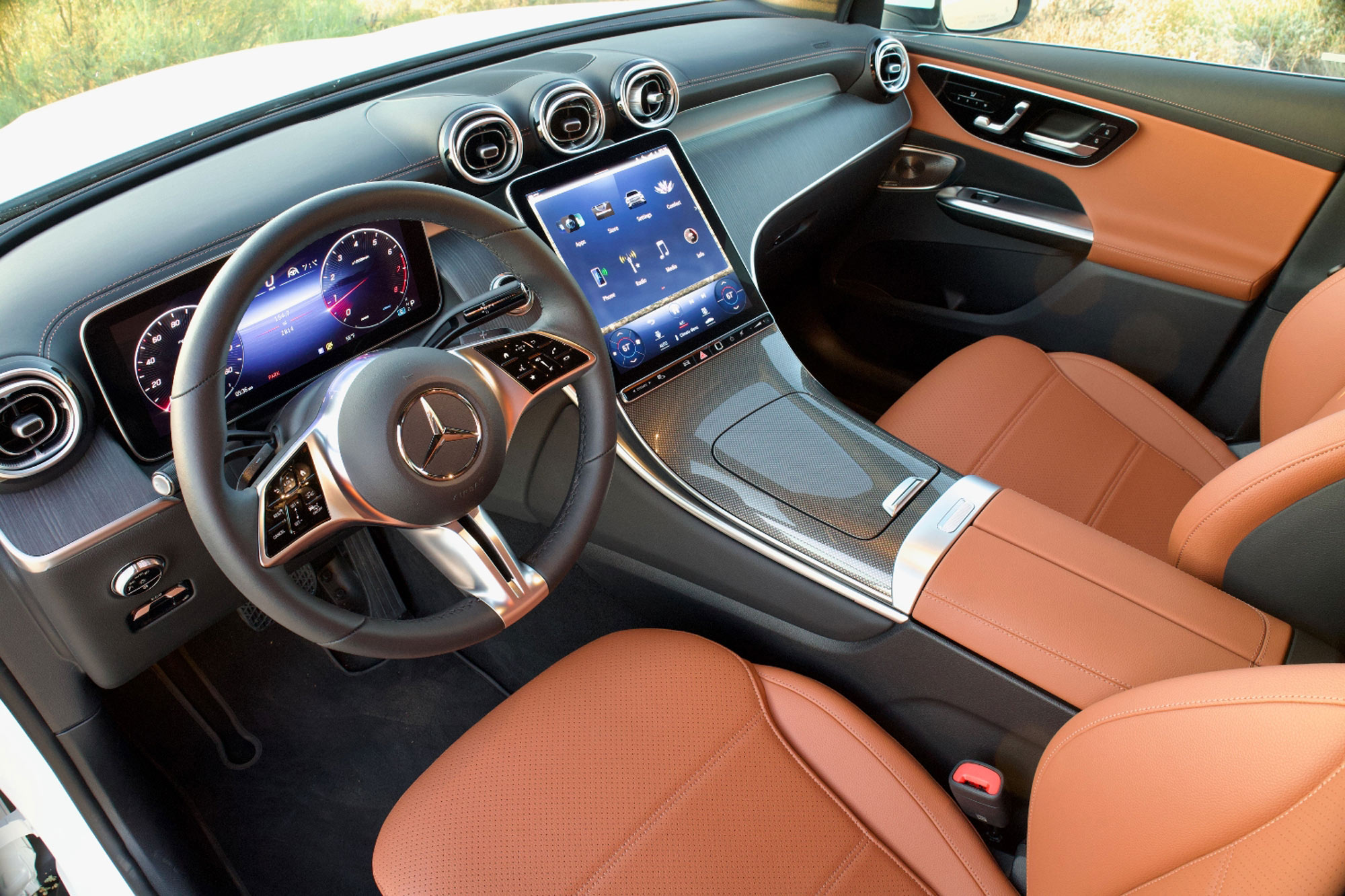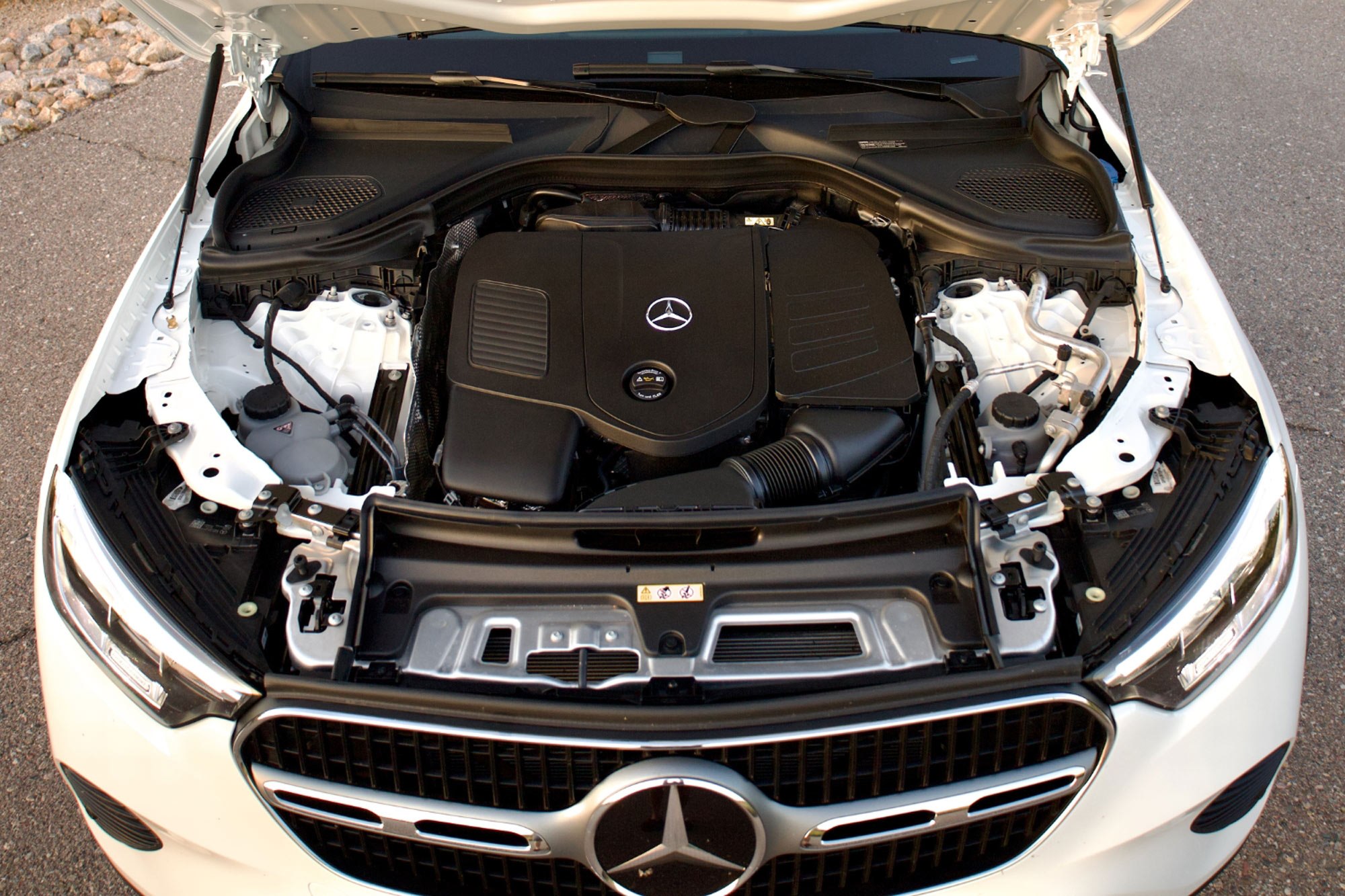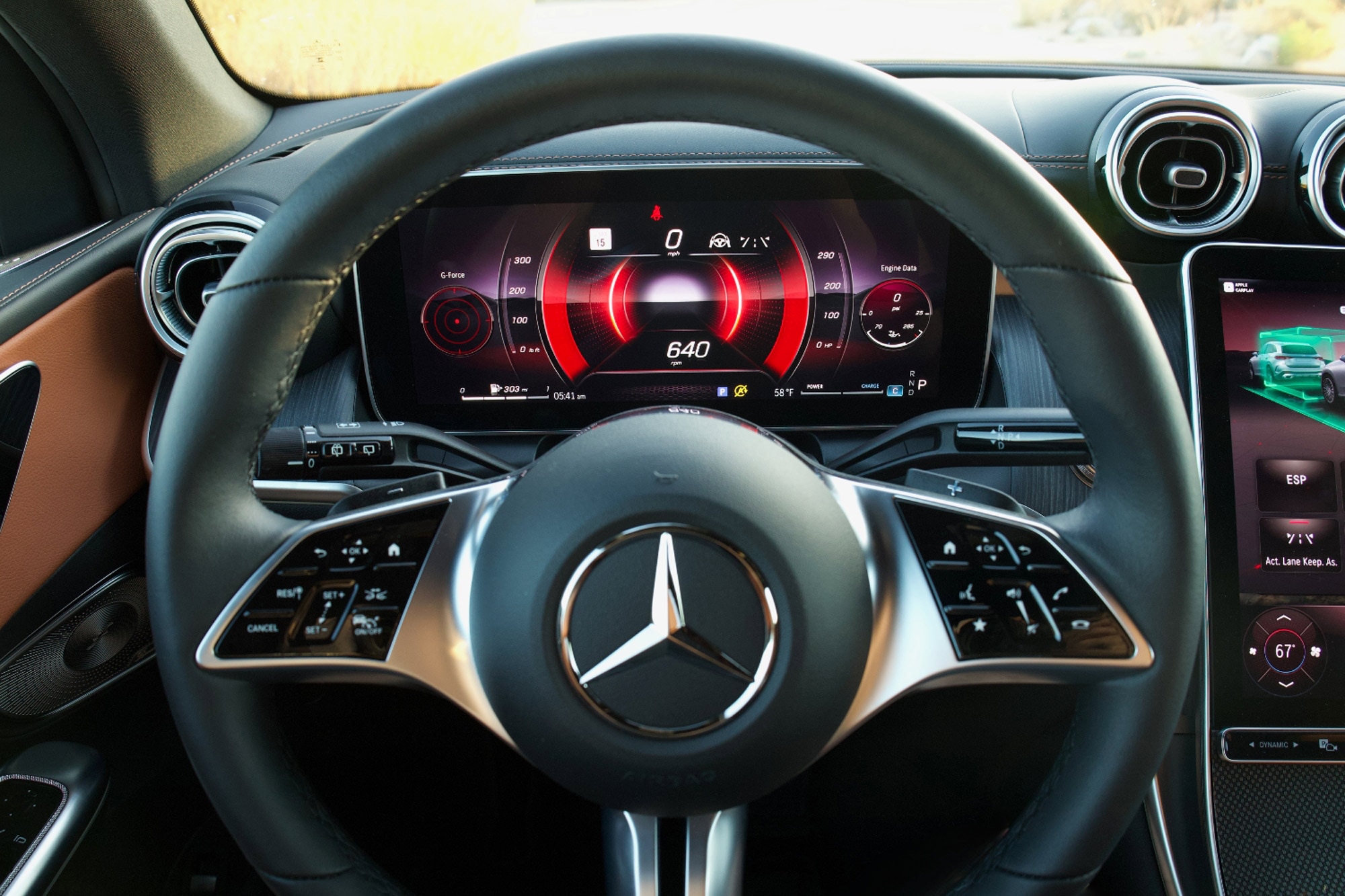2023 Mercedes-Benz GLC 300 Review and Test Drive
All new for 2023 with a mild-hybrid drivetrain and a mild design update, the GLC is a winner.
 Jim Resnick
Jim Resnick
The Mercedes-Benz GLC-Class is the top-selling vehicle in the automaker's lineup, just outselling the midsized GLE-Class in 2022. And if you have yet to notice, Mercedes-Benz offers one of the broadest stables of SUVs in the market, with eight distinct SUV lines — including pure EVs — so this is no small feat.
 Jim Resnick
Jim Resnick
Mercedes-Benz GLC 300 Faces Competition Head on
A stroll through the company's SUV garage starts with the small GLA and slightly larger GLB, hits the compact middle with the GLC, fills out with the midsized GLE, and then tops off with the large GLS and the super-luxury Mercedes-Maybach GLS variant. Toss in the pure-electric EQE SUV and EQS SUV, plus the limited-production G-Class, and you realize the brand has more SUVs than sedans or coupes.
A redesigned 2023 Mercedes-Benz GLC takes on competitors such as the Alfa Romeo Stelvio, Audi Q5, BMW X3, Genesis GV70, Jaguar F-Pace, Porsche Macan, Range Rover Evoque, and Volvo XC60. A GLC Coupe model is available this year, but it remains on the previous-generation platform, and this review does not pertain to it. A redesigned GLC Coupe arrives in 2024, along with AMG-tuned versions of both body styles.
The all-new 2023 GLC debuts as the GLC 300, equipped with a new engine making 255 horsepower coupled to an EQ Boost starter/generator mild-hybrid system that adds 23 horsepower and 148 pound-feet of torque at low engine speeds and for short bursts of acceleration. It also receives a redesigned interior with a revised dashboard using the latest Mercedes Benz User Experience (MBUX) technology.
As of publication, 2023 GLC 300 prices start in the high $40,000s, including the destination charge to ship the SUV from the Bremen, Germany, factory to your local dealership. Primary trim packages include Standard, Exclusive, and Pinnacle, and the price of a GLC 300 4Matic with Pinnacle trim falls in the mid-$50,000s.
For this 2023 Mercedes GLC review, I test-drove a GLC 300 with rear-wheel drive in Arizona. It came with the Exclusive trim package, which includes a 360-degree surround-view camera, a Burmester premium audio system, enhanced lighting, and a navigation system. In addition, the test vehicle featured an optional panoramic sunroof and a Driver Assistance Package loaded with safety features.
These extras brought the manufacturer's suggested retail price to $55,250, including the $1,150 destination charge. Mercedes-Benz provided the vehicle for this GLC 300 review.
 Jim Resnick
Jim Resnick
Mercedes-Benz GLC 300 Combines Pleasing Aesthetics With Functionality
All of Mercedes-Benz's current SUVs have a similar conservative, smooth, and soft appearance, like a gently used bar of soap. As applied to the all-new GLC, the SUV looks so similar to the old GLC that you may not notice it on the road. However, it wears new lighting, a restyled grille, updated wheels, and other minor details.
In addition, this reserved look opposes the current BMW aesthetic, which leans heavily on angular, aggressive, and even polarizing design. I believe, however, that the GLC 300 is pleasing and harmonious instead of displeasing and discordant.
Fortunately, you live inside your car, not outside it. Here, the new GLC lives up to the Mercedes reputation of high quality, good taste, and discerning style. An elegantly curved dashboard sprouts five air vents shaped like rounded-off squares, three in the middle and two on each side. At center stage sits an 11.9-inch infotainment touchscreen, and the driver faces a floating digital instrument panel.
The GLC's leather, carbon fiber, aluminum, and plastic are high grade, and nothing within the cabin feels cheap or built to a price. The doors close with a satisfying thunk, and they also don't reverberate inside, which could make them sound and feel tinny. Switches and hard buttons all have a heft and solidity to them.
 Jim Resnick
Jim Resnick
The GLC 300's interior only has one shortcoming, mainly relevant to taller drivers and front passengers. The seat bottom shape makes for easy entry and exit but at the cost of thigh and leg support on longer trips. During short-haul driving, the seats are acceptable. But on longer drives, people with long legs will find this lack of support fatiguing, as they make you move around and squirm to counteract the effect.
Back-seat occupants enjoy decent legroom. The GLC is no stretch limousine, but no one could legitimately complain. Also, there's better-than-average shoulder room thanks to the GLC greenhouse's relatively upright doors and side windows.
Storage up front is decent, with a sizable center console bin, a large glovebox, and door pockets big enough to accommodate oversized water bottles. Cargo capacity, at 21.9 cubic-feet behind the back seat, is not league leading. For comparison, the Audi Q5 has 25.9 cu-ft, and the BMW X3 offers 28.7 cu-ft.
The GLC's maximum cargo space with the back seats folded down measures 56.3 cu-ft, which is more than the Audi but less than the BMW.
 Jim Resnick
Jim Resnick
MBUX Keeps the Mercedes-Benz GLC 300 Fresh
Every new GLC has digital instrumentation and an 11.9-inch touchscreen MBUX infotainment system. As in other Mercedes, you can select how the instrumentation appears by choosing from several themes. For example, you can go with a classic look showing traditional gauges for the speedometer and tachometer, a racy avant-garde presentation, or another appearance that suits your personality.
Mercedes presents all the GLC's infotainment content through the touchscreen display at the dashboard's center. Press the Home button, and all the categories appear. In the test vehicle's case, this includes apps, vehicle settings, comfort and climate, phone, radio and media, driving information, and navigation. Over-the-air (OTA) software updates keep MBUX fresh, and you can upgrade numerous vehicle features this way.
Dive into the menus, and specific selections within items appear on the main screen. Buttons for paging back and managing the climate system always remain on the screen. Hard buttons are below the display to select a driving mode, activate the outside cameras, start the four-way emergency flashers, and adjust the audio volume. It's among the most user-friendly systems on the market today.
Pairing my iPhone with the system's Bluetooth was quick and easy, and the screen presents a CarPlay tab at the top left corner, no matter what you have in the display. This tab makes switching from operating within the car's native system to your smartphone and back again a quick and effortless action.
Some CarPlay executions force you to page through two or three menus to get from the vehicle's radio to your podcasts and the like. In this respect, Mercedes MBUX works much more seamlessly than others that don't have something similar to an ever-present CarPlay tab.
Voice recognition is similarly seamless. Utter "Hey, Mercedes," and the system wakes a digital assistant and prompts you to state what you want. The first generation of this system was a bit trigger happy, waking up when someone in the car said merely "Mercedes." But the current technology is extensively refined.
 Jim Resnick
Jim Resnick
Driver Assistance Is Optional
Comprehension by voice recognition is among the best in the field. Potentially confusing names like "Chipotle" or linguistic accents didn't trip it up. Even if you declare, "I'm cold," the digital assistant instructs the climate controls to raise the temperature and fan speed.
Thanks to the optional Driver Assistance Package, all the latest driving assistance and collision avoidance systems were on the test vehicle. These include:
- Adaptive cruise control
- Lane-departure warning
- Lane-keeping assist
- Lane-change assist
- Active blind-spot monitoring
- Rear cross-traffic alert
- Active emergency-stop assist
- Active speed-limit assist
- Route-based speed control
In recent years and across all automakers, lane-keeping assist has been the easiest among all these systems to become confused. Some of them might mistake a long groove in the road for a lane edge line — sometimes called the fog line — at the right edge of that road and input a steering change because of it. Gaps in those edge lines can also confuse things. However, the new GLC 300 never put a foot (or tire) wrong in the lane-keeping department throughout this evaluation.
The Driver Assistance Package is complete but costs an additional $1,950. Among the truckload of driver assistance systems now commonly standard regardless of the vehicle price, the GLC 300 only includes forward-collision warning, automatic emergency braking, and blind-spot monitoring in the base price. More of these features should be standard on any car, SUV, or truck sold in the U.S., especially a Mercedes.
As of publication and due to its complete redesign, the 2023 Mercedes GLC crash-test ratings are unavailable from both the National Highway Traffic Safety Administration and the Insurance Institute for Highway Safety.
 Jim Resnick
Jim Resnick
An EQ Boost System Worth Bragging About
There's no doubting the effectiveness of the mild-hybrid EQ Boost system onboard the 2023 Mercedes GLC 300. This motor/generator adds 23 horsepower and 148 lb-ft of torque to the turbocharged 2.0-liter four-cylinder engine, which makes an already-stout 255 horses and 295 lb-ft of torque without any outside assistance. That electrified EQ Boost makes the turbocharged GLC 300 launch from a dead stop with real gusto, accelerating to 60 mph in 6.2 seconds, according to Mercedes.
That extra oomph comes with no penalty in gas mileage. Mercedes says the GLC 300 rear-wheel-drive model will get 25/32/28 mpg city/highway/combined driving, compared to 22/27/24 mpg in the outgoing 2022 model. Despite several hard acceleration runs, my 73-mile test loop of mixed highway, suburban, and urban driving returned a better-than-advertised 28.7 mpg.
You don't have to be a drag racer to appreciate the GLC 300's drivetrain. The SUV's engine stop-start system is the smoothest I've encountered recently. The engine awakes from a stop almost undetectably. Similarly, it sometimes shuts off before coming to an actual stop, giving a slightly stealthy approach to a stoplight. Unfortunately, the GLC's steering feel is just as stealthy, not a trait most would enjoy. And modulating brake pedal effort to match your anticipated slowing rate feels a little more touchy than expected.
 Jim Resnick
Jim Resnick
As with most Mercedes models, the GLC 300 uses an electronic steering-column-mounted stalk to shift the nine-speed automatic transmission from Park to Drive and Reverse. By design, the test vehicle's shift stalk creates a pause when engaging Drive and Reverse. That is due to the transmission's programming, and the delay helps to reduce or eliminate shift shock, which can damage a transmission.
Preventing damage is fine and noble, but the pause was more noticeable in this GLC test vehicle than in other Mercedes vehicles I've recently driven.
Sadly, the GLC 300's handling agility doesn't quite match the willingness of the powertrain. To be clear, the GLC 300 is not a sporty, AMG-tuned vehicle. And the comfortable ride quality is what you'd expect of a larger Mercedes. Even faster highway velocity registers only a whisper of relative noise.
However, the GLC 300 doesn't beg to carve up twisty roads. An optional AMG package is available, and there will eventually be an AMG GLC model or two in the lineup. But as tested, the GLC 300 is not exactly a cornering king.
 Jim Resnick
Jim Resnick
The GLC 300 Is a Well-Rounded SUV
The redesigned 2023 Mercedes-Benz GLC 300 is a well-rounded SUV when stacked against its competition.
The updated powertrain punches way above its weight. Inside, it's roomy enough, elegant, and cleanly designed with fine details, with only long-legged front occupants potentially irked at the lack of thigh support. Outside, it's conservatively appealing if not exciting. Infotainment user-friendliness is just about the best in the field, and the available driver assistance package collection is comprehensive.
The only real disappointments include the front seat support, handling crispness that falls short of par with the powertrain's eagerness, and the fact that the latest active safety systems are optional.
The GLC being a Mercedes means it is also on the expensive side. However, Mercedes-Benz vehicles have always cost more than the competition, so compact luxury SUV shoppers should expect this.
Written by humans.
Edited by humans.
 Jim Resnick
Jim ResnickFrom racing exotic sports cars, to ranking new cars, to peeling back layers of cover up in an exhaust emissions scandal, Jim has chronicled the automotive sector for decades. Jim has also worked inside the corporate headquarters of three carmakers, and therefore understands how the automotive sausage is really made. But Jim’s affinity for vehicles takes a back seat to finding the truth and the cultural implications of modern transportation. He has also lectured at universities to engineering and policy students and faculty on the industry’s relationship with legislation in the wake of the diesel exhaust emissions scandal several years ago. Put simply, Jim reports on autos, mobility, tech, car culture, and the traffic jam of topics within.
Related articles
View more related articles